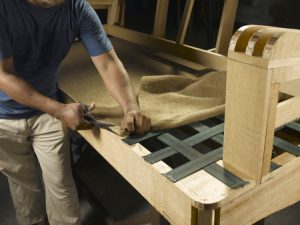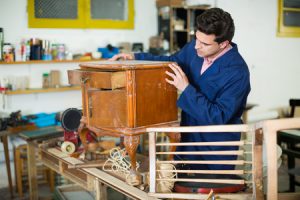Furniture Remanufacture
Paul Kerlaff from Napier University provides a thought provoking insight into design for reuse in furniture
Drivers towards Design for Re-Use
 The history of chairs is in many ways the history of sitting. In his 2016 book Now I Sit Me Down, American architectural critic Witold Rybczynski describes how the humble wooden rocker represents a kind of democratic ideal; one was proscribed for President Kennedy to alleviate back pain. High backed dining chairs of the eighteenth century played the opposite role; their backs were deliberately heavy, so ownership also implied the command of an army of servants to move chairs in behind a diner. The history of sitting is also a history of how we live.
The history of chairs is in many ways the history of sitting. In his 2016 book Now I Sit Me Down, American architectural critic Witold Rybczynski describes how the humble wooden rocker represents a kind of democratic ideal; one was proscribed for President Kennedy to alleviate back pain. High backed dining chairs of the eighteenth century played the opposite role; their backs were deliberately heavy, so ownership also implied the command of an army of servants to move chairs in behind a diner. The history of sitting is also a history of how we live.
A social anthropologist of the future might well puzzle over artifacts unearthed from our landfill landscapes. An injection-molded chair, its polypropylene barely changed from two hundred years of burial, would be a hard one to decipher. Some kind of ritual sacrifice perhaps? Our material knowledge supports an abundance of potential afterlives for furniture, and yet we seem unsure ourselves of what these afterlives might be. The three cycles of use proposed by office furniture suppliers Desko currently appears wildly ambitious for domestic furniture.
If our history really is intertwined with artifacts, what would persuade us to design these artifacts for re-use? For our ancestors the incentive was inheritance; investment in a major item of furniture was justified by the potential benefit to one’s offspring. Inheritance justifies furniture with commodity, firmness and delight, the very characteristics associated with permanence, with architecture. But inheritance of furniture becomes less delightful in the context of a rented flat, a portfolio career and the mobility demanded by modern life.
Design for re-use can be thought of as a type of conceptual inheritance, motivated not by the shoring up of one’s own gene pool but by the potential gains of designing and making furniture that can be re-used, traded up or combined to make new furniture for minimal cost. From a design point of view, this is brilliant news, because design for re-use requires all three of the heirloom attributes: commodity, to be bought in the first place; firmness, to survive three or more lifespans, and delight, because we need furniture to be delightful in order to enrich our lives.
Challenges of Design for Re-Use
 Our biggest challenge is not so much the design of objects for re-use, but our patterns of behavior that support the re-use itself. To designers, this is a collossal disappointment, because on the whole we like to think of ourselves as invaluable in creating commodity and firmness in objects, and not bad at the delight side of things either. We take on projects not knowing precisely what the technical solution might be, but confident that our experience and ability to innovate in partnership with others will get us there. The attraction to design for re-use is, in my case at least, partly selfish – I see the chance to design lovely things to parameters that align with good design in a wider sense. The idea that a designed thing might be around for longer, and therefore have more impact, also resonates with many who entered the profession for the satisfaction of creating enrichment through better made things.
Our biggest challenge is not so much the design of objects for re-use, but our patterns of behavior that support the re-use itself. To designers, this is a collossal disappointment, because on the whole we like to think of ourselves as invaluable in creating commodity and firmness in objects, and not bad at the delight side of things either. We take on projects not knowing precisely what the technical solution might be, but confident that our experience and ability to innovate in partnership with others will get us there. The attraction to design for re-use is, in my case at least, partly selfish – I see the chance to design lovely things to parameters that align with good design in a wider sense. The idea that a designed thing might be around for longer, and therefore have more impact, also resonates with many who entered the profession for the satisfaction of creating enrichment through better made things.
But in order to achieve this impact, we need more than material durability. The paradigm of designer as artist is pretty redundant here; the lone genius in his or her garret is unlikely to understand how a user will feel about a kitchen table two, or five, or twenty years from now. It would be tempting to think that cunning re-use of materials, local sourcing and technical innovation would carry a proposal through the multiple life cycles we need, but history tells us that the quality of design alone is almost never sufficient. Designing systems of ownership, finance, recovery, and evaluation are as important as modularity, durability, ergonomics and material provenance, because the latter attributes never get the opportunity to be valued without the former.
We have a kind of material dependency in realizing design for re-use that cannot be solved by specification alone, and which pulls the role of designer into research-led understanding of our relationship to things. This is not design disruption for it’s own sake or to open up markets. The disruption is happening anyway; our role as designers is to understand how systems of use can operate within this change and sustain a viable future of ownership, enrichment and delight.
